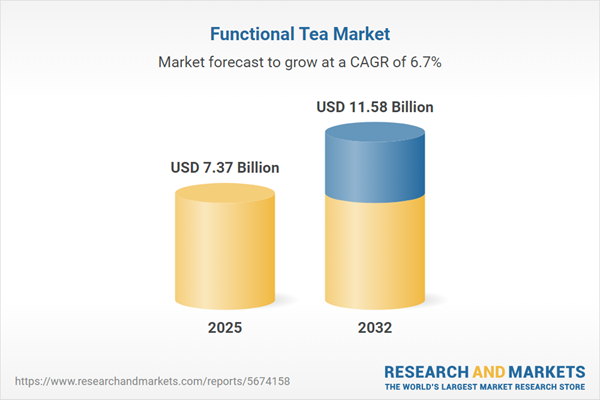Speak directly to the analyst to clarify any post sales queries you may have.
The functional tea market is rapidly evolving, characterized by willingness among consumers to pay for differentiated wellness benefits. Companies are leveraging scientific innovation, premium packaging, and targeted formulations to capture market share and address health-focused demand.
Market Snapshot: Growth and Expansion in Functional Tea
The functional tea market grew from USD 6.90 billion in 2024 to USD 7.37 billion in 2025, and is projected to reach USD 11.58 billion by 2032 at a CAGR of 6.69%. The sector’s expansion is propelled by consumers seeking targeted wellness, with brands responding through innovative blends featuring botanicals, adaptogens, and nutrient-rich ingredients. This surging demand is evident across business models ranging from multinationals to agile start-ups, each deploying strategies to address both mainstream and premium market segments.
Scope & Segmentation: Functional Tea Market Landscape
- Product Types: Black tea (Darjeeling, Earl Grey, English Breakfast); Fruit tea (Apple, Berry, Citrus blends); Green tea (Longjing, Matcha, Sencha); Herbal tea (Chamomile, Ginger, Peppermint); Oolong tea (Da Hong Pao, Tieguanyin); White tea (Silver Needle, White Peony).
- Packaging Types: Canisters (cardboard, metal); Loose leaf (bulk, wrapped); Pyramid bags (nylon, PLA); Tea bags (envelope, standard).
- Application Scenarios: Hot tea (ceremonial, informal); Iced tea (sweetened, unsweetened); Ready to drink (bottled, canned, carton formats).
- Distribution Channels: Offline outlets; Online retail (brand websites, e-commerce platforms).
- Regional Coverage: Americas (North America: United States, Canada, Mexico; Latin America: Brazil, Argentina, Chile, Colombia, Peru); Europe, Middle East & Africa (Europe, Middle East, Africa); Asia-Pacific (China, India, Japan, Australia, South Korea, Indonesia, Thailand, Malaysia, Singapore, Taiwan).
- Leading Companies: Unilever PLC, Tata Consumer Products Limited, Associated British Foods PLC, Hain Celestial Group, Inc., Nestlé S.A., Ito En, Ltd., The Coca-Cola Company, The J. M. Smucker Company, Bigelow Tea Company, The Republic of Tea, Inc.
Key Takeaways for Senior Decision-Makers
- Functional tea blends integrate established herbal traditions and modern extraction science, enabling precise health solutions tailored to gut, cognitive, immune, and stress-related needs.
- Premiumization and differentiation are achieved through unique ingredient combinations, limited-edition releases, and specialty packaging—elements that also drive margin expansion.
- Personalization, from customizable blends to adaptive digital experiences, boosts consumer engagement and brand loyalty, while supporting advanced data analytics for targeted marketing.
- Sustainability commitments, such as eco-friendly packaging, traceable sourcing, and ethical supply chain oversight, have become foundational to long-term brand credibility and competitive positioning.
- Technology adoption—including advanced extraction, nanoparticle delivery, and immersive digital engagement—enhances product efficacy and deepens audience connection.
- Agile market players are increasingly leveraging vertically integrated supply chains to shield against cost volatility and regulatory shifts, ensuring resilience and operational efficiency.
Tariff Impact on Supply Chains
Recent United States tariff policies on imported tea leaves and ingredients have reshaped sourcing strategies, triggered cost reviews, and led producers to pivot towards alternative origin countries. Brands have strengthened long-term partnerships, diversified suppliers, and looked to domestic packaging to ease input burdens. These actions are critical for maintaining price stability and mitigating exposure to trade-driven margin compression.
Methodology & Data Sources
This report applies a combined methodology of in-depth primary interviews with industry stakeholders and secondary data analysis, drawing from public records, scientific publications, and market intelligence databases. Analytical rigor is reinforced by advisory panel reviews and iterative validation to ensure reliability and actionable findings.
Why This Report Matters for the Functional Tea Market
- Enables precise strategic planning by illuminating technology adoption, consumer trends, and regional market landscapes.
- Supports risk mitigation through insights on supply chain adaptation, regulatory changes, and competitive dynamics.
- Provides actionable benchmarking for product innovation, channel expansion, and sustainability investments aligned with evolving priorities.
Conclusion
The functional tea market is progressing through innovation, operational adaptability, and evidence-driven consumer engagement. Strategic investments in product research, sustainable practices, and omnichannel approaches are essential for building market leadership and long-term value.
Additional Product Information:
- Purchase of this report includes 1 year online access with quarterly updates.
- This report can be updated on request. Please contact our Customer Experience team using the Ask a Question widget on our website.
Table of Contents
3. Executive Summary
4. Market Overview
7. Cumulative Impact of Artificial Intelligence 2025
Companies Mentioned
The companies profiled in this Functional Tea market report include:- Unilever PLC
- Tata Consumer Products Limited
- Associated British Foods PLC
- Hain Celestial Group, Inc.
- Nestlé S.A.
- Ito En, Ltd.
- The Coca-Cola Company
- The J. M. Smucker Company
- Bigelow Tea Company
- The Republic of Tea, Inc.
Table Information
| Report Attribute | Details |
|---|---|
| No. of Pages | 181 |
| Published | October 2025 |
| Forecast Period | 2025 - 2032 |
| Estimated Market Value ( USD | $ 7.37 Billion |
| Forecasted Market Value ( USD | $ 11.58 Billion |
| Compound Annual Growth Rate | 6.6% |
| Regions Covered | Global |
| No. of Companies Mentioned | 11 |









